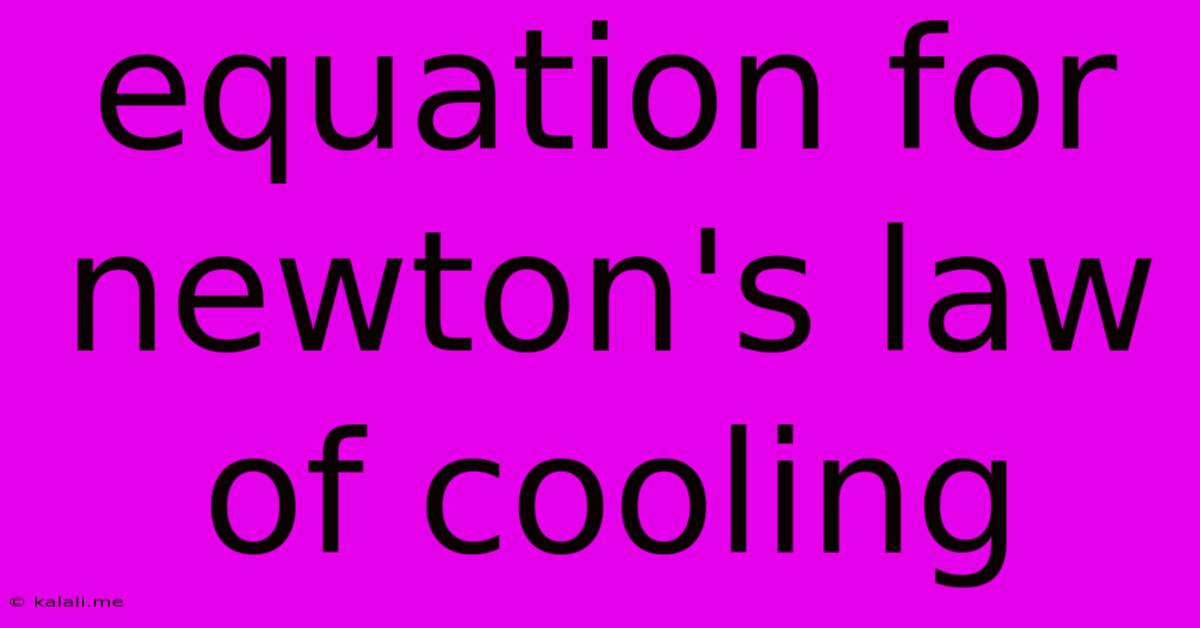Equation For Newton's Law Of Cooling
Kalali
Jun 12, 2025 · 3 min read

Table of Contents
Understanding and Applying the Equation for Newton's Law of Cooling
Newton's Law of Cooling describes the rate at which an object's temperature changes as it approaches thermal equilibrium with its surroundings. Understanding its equation is crucial for various applications, from predicting coffee cooling time to analyzing heat transfer in engineering. This article will delve into the equation, its derivation, applications, and limitations.
What is Newton's Law of Cooling?
In essence, Newton's Law of Cooling states that the rate of heat loss of a body is directly proportional to the difference in temperatures between the body and its surroundings. This means a hotter object will cool down faster in a colder environment than a slightly warmer object. This principle finds widespread use in fields like physics, chemistry, and engineering.
The Equation: Deconstructing the Formula
The mathematical representation of Newton's Law of Cooling is:
dT/dt = -k(T - Tₐ)
Where:
- dT/dt: Represents the rate of change of the object's temperature (T) with respect to time (t). It's the derivative of temperature with respect to time.
- -k: Is a positive constant that depends on the properties of the object and its environment (surface area, material, heat transfer coefficient, etc.). The negative sign indicates that the temperature decreases over time (cooling).
- T: Is the temperature of the object at time t.
- Tₐ: Is the ambient temperature (the temperature of the surroundings), which is assumed to be constant.
Solving the Differential Equation
The equation above is a separable differential equation. Solving it involves separating the variables and integrating:
-
Separate Variables: Rewrite the equation as:
(dT)/(T - Tₐ) = -k dt -
Integrate Both Sides:
∫(dT)/(T - Tₐ) = ∫-k dt -
Solve the Integrals: This yields:
ln|T - Tₐ| = -kt + Cwhere C is the constant of integration. -
Solve for T: Exponentiate both sides to remove the natural logarithm:
T - Tₐ = e^(-kt + C) = Ae^(-kt)where A = e^C is another constant. -
Determine the Constant A: Using the initial condition, where T = T₀ at t = 0, we get:
A = T₀ - Tₐ -
Final Solution: The final equation representing the temperature of the object at any time t is:
T(t) = Tₐ + (T₀ - Tₐ)e^(-kt)
This equation allows us to predict the temperature of the object (T) at any given time (t), given the initial temperature (T₀), the ambient temperature (Tₐ), and the cooling constant (k).
Applications of Newton's Law of Cooling
The applications of this law are diverse and include:
- Forensic Science: Estimating the time of death by analyzing the body's cooling rate.
- Food Science: Determining the cooling time of food products to ensure safety and quality.
- Engineering: Designing cooling systems for electronic components and engines.
- Meteorology: Modeling atmospheric temperature changes.
Limitations of Newton's Law of Cooling
While a valuable tool, Newton's Law of Cooling has limitations:
- Assumes Constant Ambient Temperature: The law's accuracy diminishes when the ambient temperature fluctuates significantly.
- Neglects Radiation and Convection: The model primarily considers conduction; radiation and convection effects can be significant in certain scenarios.
- Approximation for Small Temperature Differences: The law is most accurate when the temperature difference between the object and its surroundings is relatively small.
Conclusion
Newton's Law of Cooling provides a straightforward yet powerful model for understanding and predicting temperature changes in various systems. While it has limitations, its simplicity and wide applicability make it an essential concept in numerous scientific and engineering disciplines. By understanding its equation and limitations, one can effectively apply it to solve practical problems involving heat transfer.
Latest Posts
Latest Posts
-
Elements On The Right Side Of The Periodic Table Are
Jun 13, 2025
-
The Time And Place Of A Story
Jun 13, 2025
-
The Largest Satellite In The Solar System
Jun 13, 2025
-
Metal In Liquid State At Room Temperature
Jun 13, 2025
-
The Slope Of A Velocity Time Graph Will Give
Jun 13, 2025
Related Post
Thank you for visiting our website which covers about Equation For Newton's Law Of Cooling . We hope the information provided has been useful to you. Feel free to contact us if you have any questions or need further assistance. See you next time and don't miss to bookmark.